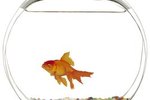
Most fish have a preferred depth. A happy, healthy gourami will usually swim in the upper reaches of an aquarium. If it is hanging out near the bottom of the aquarium, this probably indicates that something has gone wrong. Stress and disease are usually the causes of such a situation. You should identify the cause as soon as possible so you can correct it.
Swimming
Normal behavior for a gourami involves swimming near the top of the aquarium. Gouramis have a structure in their gills called the labyrinth organ, a bit of anatomy they share with their close relatives the bettas. This organ allows them to breath oxygen from the air. As such, gouramis tend to hang out near the water surface, so they can take their supplemental oxygen. A gourami hanging out near the bottom of an aquarium is a sign that something has gone wrong with the fish.
Stress
Stress can make gouramis skittish and more likely to hug the bottom of an aquarium. Poor water quality or incorrect water parameters can stress most fish. However, most gouramis are so undemanding that this scenario is somewhat unlikely. The sole exception is the paradise fish, sometimes sold as the paradise gourami. These fish come from colder, subtropical water, so the higher temperatures of most aquariums can stress them out. Fighting and bullying are other likely causes of stress. Gouramis are notoriously aggressive as a group, and fighting leads to stress. Gouramis' long fins makes them perfect targets for fin-nipping by smaller, faster fish. Identify the cause of your gouramis' stress and prevent it; the fish should be fine.
Disease
Illness may be a cause of a gourami sulking near the bottom of an aquarium. This may manifest in number of ways. Look for things like unusual discoloration, spots, bumps, lesions and fin damage. Aquarium fish like gouramis can suffer from hundreds of diseases, and if you see symptoms, you may need further research to figure out exactly what's wrong.
Shock
While gouramis as a group are hardy, sudden changes in water chemistry or temperature can stress them. If you've just introduced your low-floating gourami to the aquarium, this is a possibility. The fish might recover. To avoid this problem in the future, floating the bag for 10 minutes, then gradually add water from the aquarium to the bag over the course of an hour until there is a 3-to-1 ratio of aquarium water to bag water. Then release the fish into the aquarium.
References
- FishChannel.com: Aquarium Fish Stress
- FishChannel.com: Blue Gourami Fish
- FishChannel.com: Dwarf Gourami Fish
- FishChannel.com: Acclimating New Aquarium Fish
- Seriously Fish: Macropodus opercularis -- Paradise Fish
- Complete Idiot's Guide to Freshwater Aquariums; Maddy Hargrove
Photo Credits
-
NA/AbleStock.com/Getty Images




